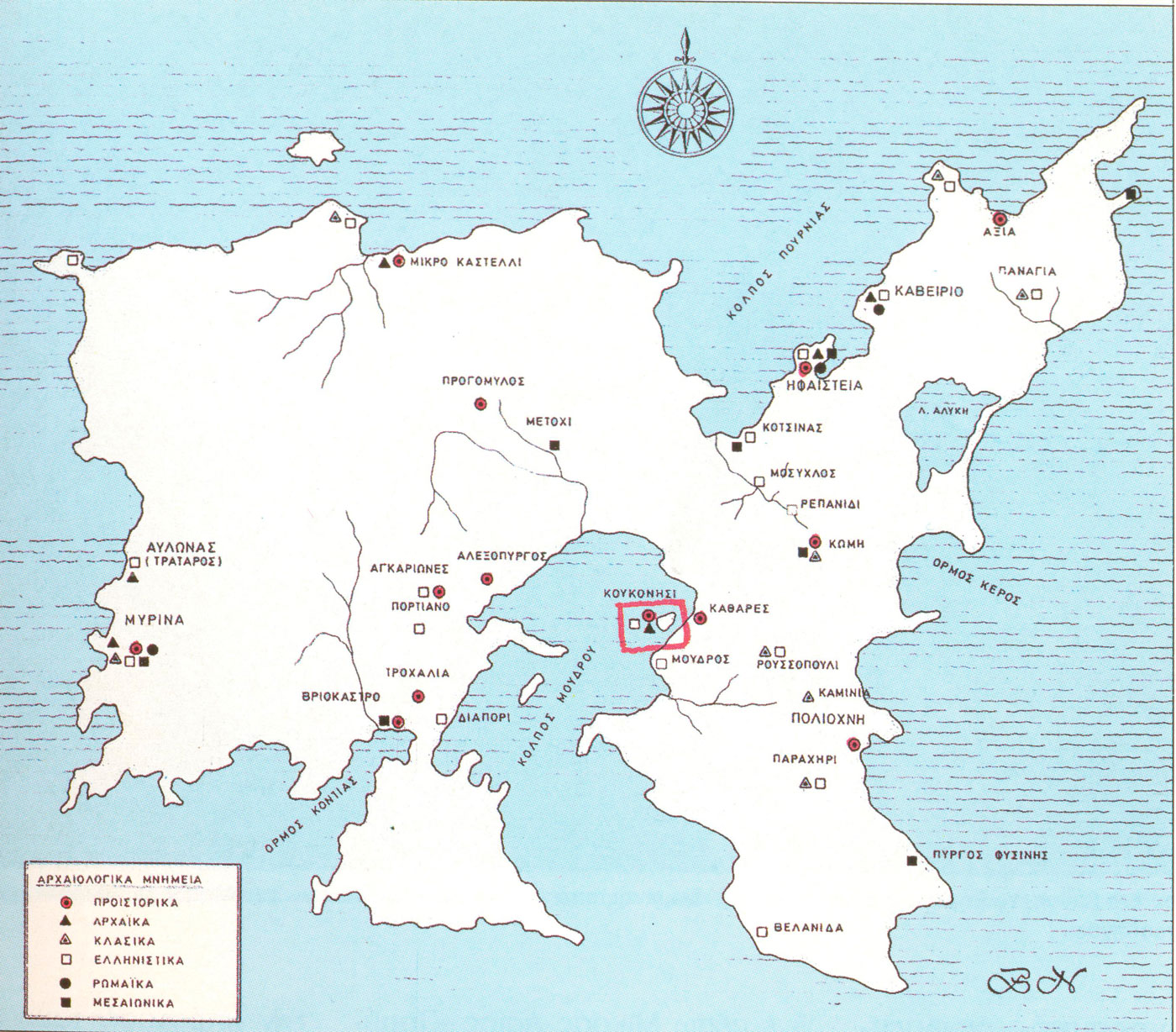
Island of Hephaestus
Lemnos is an island in the northeastern Aegean.Each side of the island is facing one point of the horizon.East of Lemnos are the coasts of Mikra Asia and Tenedos and northeast Imbros.The closest point of mainland Greece is the third leg of Halkidiki, the peninsula of Mount Athos.In fact the shadow of this mountain reaches the island, as Sophocles had observed.With the qualitative poetry of Homer he appears on the stage of historical times:” To beloved Lemnos”.He trades with the Achaeans and facilitates them in hte Trojan War.At the same time it hosts Philoctetes and heals him with the land of Lemnia.This is where Hephaestus will set up his workshop, when he will land awkwardly on the island, accepting the wrath of the angry Zeus.Windy due to the winds, Amichthaloessa (foggy),Sintis from its old inhabitants.They called her also Ampeloussa(Wineyard).Finnaly the name Lemnos prevails.A word of Phoenician origin that means white and probably prevailed beacause of the white face of the island to anyone who approaches it from the sea.The name Lemnos appears for the first time on clay tablets of Pylos, dating from the 13th century BC.Remains here as the guardian of the Greek tradition in the NE Aegean, waiting for you to get to know it up close.With crystal clear seas, unforgettable sandy beaches,waiting to charm you.”To beloved Lemnos” then.
Prehistoric times
The first people, who lived in Lemnos, were of the Middle Neolithic era during the 5th millennium BC.It is most likely that the came from Central Asia and it seems that they inhabited the whole island,since Neolithic settlements have been found in many parts of it, such as Axia,Iphaestia and Komi.They managed to develop a remarkable culture with continuity in Poliochni where during 1500 years the settlement that started as a small Neolithic village ended up in a thriving city of the Bronze Age that dominated both the island and its maritime surroundings.
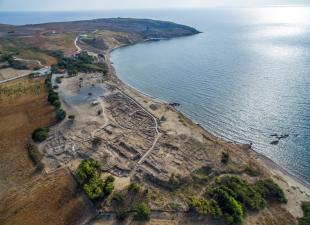 Poliochni, located in the eastern part of the island, at Vroskopos near the village of Kaminia,was one of the most important settlements in the Aegean during the 3rd millenium BC and today is the oldest prehistoric settlement in Europe.
Poliochni, located in the eastern part of the island, at Vroskopos near the village of Kaminia,was one of the most important settlements in the Aegean during the 3rd millenium BC and today is the oldest prehistoric settlement in Europe.
The constraction phases of this prehistoric settlement cover without interruption the entire 3rd millenium BC while the findings have come to light show that the city was abandoned for a long time and reactivated, but sporadically during the 2nd millenium.
Poliochni was discovered in the summer of 1930, after researchs carried out at the site by the Italian Archaeological Scool of Athens.The excavations took place in two periods, the first lasting from 1930 to 1936 and the second post-war from 1951 to 1956.Maintance and cleaning work were carried out from 1986 to 1995.
The excavations revealed very important findings.It is a large part of a settlement of the Early Bronze Age, with many phases of architectural and cultural development that cover the entire 3rd BC millenium.
Parts of the monumental wall and two of the most important buildings unearthed in Poliochni, have been dated to the Blue Age (3200-2700BC).There are the so called ”Vouleftirio” and the community ”Barn”, which built on the inside of the wall, defined the southern and nothern sides of the western gate of the settlement.
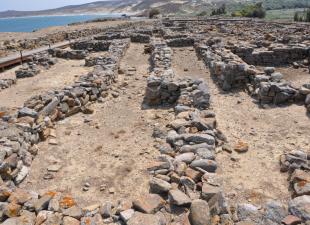 The southern building (Vouleftirion) is elongated and has along its long sides two steps of stone benches, on which it is estimated that about fifty people could sit.Although it is not disputed that the space was intended for public gatherings, it is difficult to determine the nature of these gatherings.In other words, it could serve social,religious,economic,political activities.
The southern building (Vouleftirion) is elongated and has along its long sides two steps of stone benches, on which it is estimated that about fifty people could sit.Although it is not disputed that the space was intended for public gatherings, it is difficult to determine the nature of these gatherings.In other words, it could serve social,religious,economic,political activities.
However, its long life and the fact that none of the other buildings of the settlement, which have been discovered so far, provide evidence that could characterize it as the seat of some authority or power, reinforce the view that political gatherings can not to be excluded. In other words, in this building we can see in a fetal form the market of classical times. His name as “Bouleftiriou” was also based on this view.
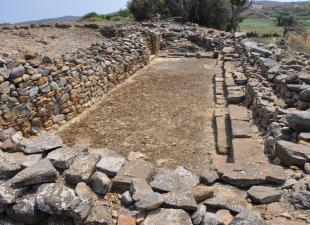 The operation of the other building, the Barn, seems clearer. In the shape of elongated and devoid of doors and windows (it has only small ventilation openings) it certainly served storage needs. This interpretation is aided by the presence of two low walls crosswise arranged on the floor, which were interpreted as backgrounds to support a wooden floor. With this layout, air could circulate under the wooden floor and prevent moisture from affecting the stored goods.
The operation of the other building, the Barn, seems clearer. In the shape of elongated and devoid of doors and windows (it has only small ventilation openings) it certainly served storage needs. This interpretation is aided by the presence of two low walls crosswise arranged on the floor, which were interpreted as backgrounds to support a wooden floor. With this layout, air could circulate under the wooden floor and prevent moisture from affecting the stored goods.
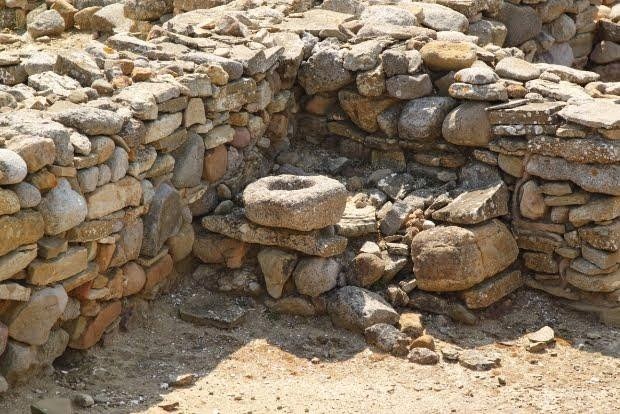 Among the other constructions of public character are the cobbled streets and squares, the sewerage network and the water wells of the settlement.
Among the other constructions of public character are the cobbled streets and squares, the sewerage network and the water wells of the settlement.
It was suddenly destroyed around 1300 BC most likely from an earthquake.After its destruction, the capital and center of the island became Myrina, named after his wife Thoanta and queen of the island.
Ancient Lemnos
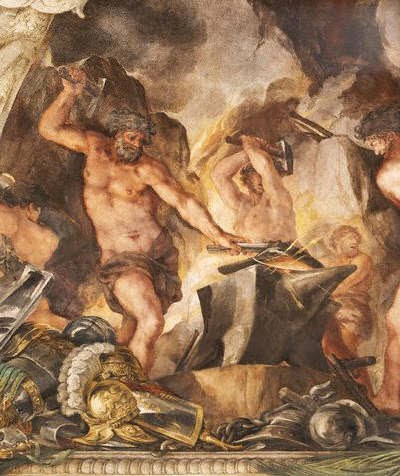 The development of metallurgy by the oldest inhabitants of the island was attributed to the god Hephaestus.
The development of metallurgy by the oldest inhabitants of the island was attributed to the god Hephaestus.
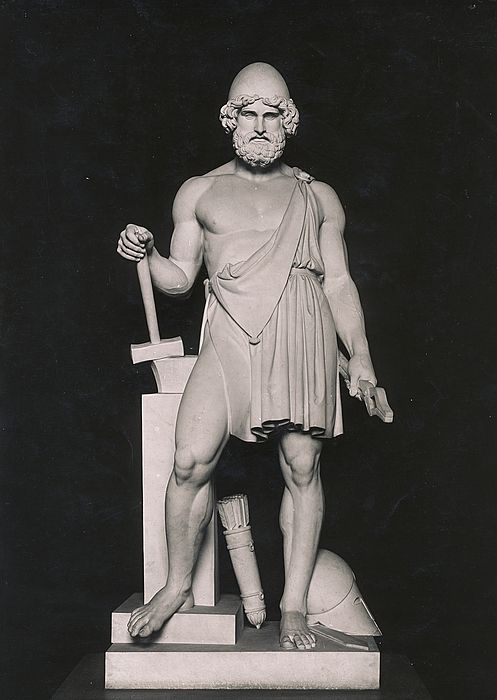 According to the legend, Zeus, after a quarrel with Hera, threw Hephaestus from Olympus, as he defended his mother, as a result of which he fell in Lemnos and since then he has been crippled. The first inhabitants of the island, whom Homer calls Cynthia, who according to legend came from the East and were savage (= cruel, inhospitable), treated him and he in return taught them the art of metalworking, setting up the workshop on the Mosychlos volcano of Lemnos.
According to the legend, Zeus, after a quarrel with Hera, threw Hephaestus from Olympus, as he defended his mother, as a result of which he fell in Lemnos and since then he has been crippled. The first inhabitants of the island, whom Homer calls Cynthia, who according to legend came from the East and were savage (= cruel, inhospitable), treated him and he in return taught them the art of metalworking, setting up the workshop on the Mosychlos volcano of Lemnos.
The Cynthians were excellent metallurgists and the first to make bronze weapons with metals from Mikra Asia. In honor of the metallurgical god, the ancient Greeks named Hepheastia the city they founded on the island. Hepheastia was one of the two most important cities of Lemnos. The other was the ancient Myrina, which is why Lemnos was also called Dipolis.
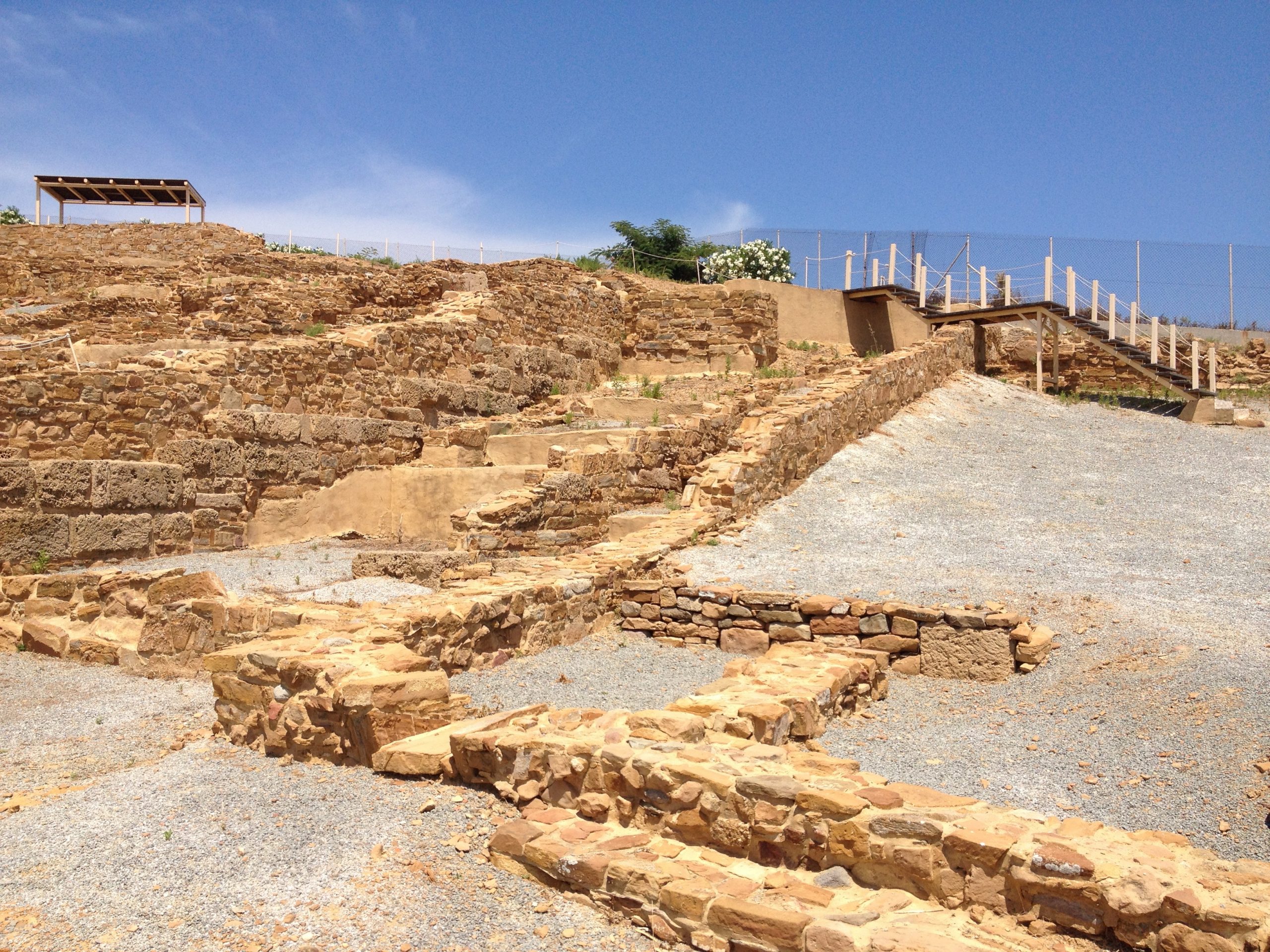 Hephaestia, built in the bay of Pournias, on the northeastern side of the island, was in historical times, the second most important city of Lemnos, after Myrina. It dates from the Chalcolithic era and seems to have been inhabited continuously until the Byzantine years. The excavations carried out by the Italian School of Archeology and the K ‘Ephorate of prehistoric and classical antiquities, brought to light antiquities that document the continuous habitation in the area from the Late Bronze Age to the Byzantine times.
Hephaestia, built in the bay of Pournias, on the northeastern side of the island, was in historical times, the second most important city of Lemnos, after Myrina. It dates from the Chalcolithic era and seems to have been inhabited continuously until the Byzantine years. The excavations carried out by the Italian School of Archeology and the K ‘Ephorate of prehistoric and classical antiquities, brought to light antiquities that document the continuous habitation in the area from the Late Bronze Age to the Byzantine times.
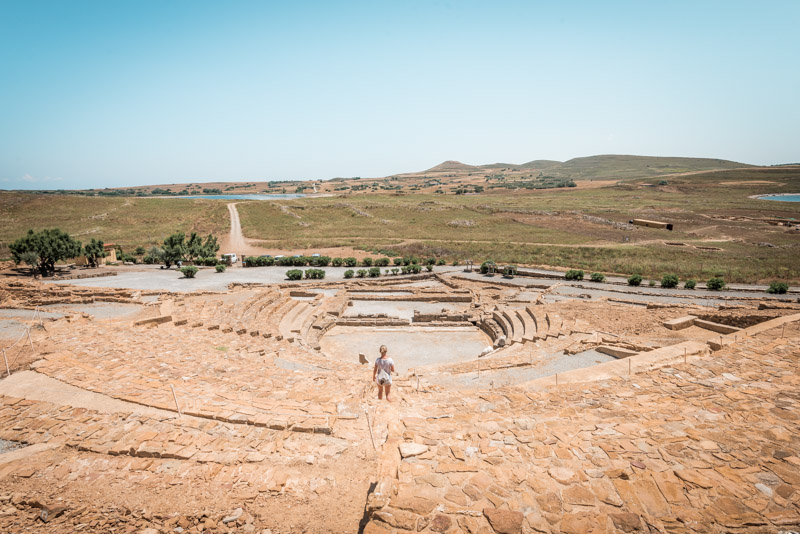 Archaeological excavations were able to reveal, among others, the sanctuary of the Great Goddess, necropolises, baths, a large building – probably a palace and a Hellenistic-Roman theater.
Archaeological excavations were able to reveal, among others, the sanctuary of the Great Goddess, necropolises, baths, a large building – probably a palace and a Hellenistic-Roman theater. 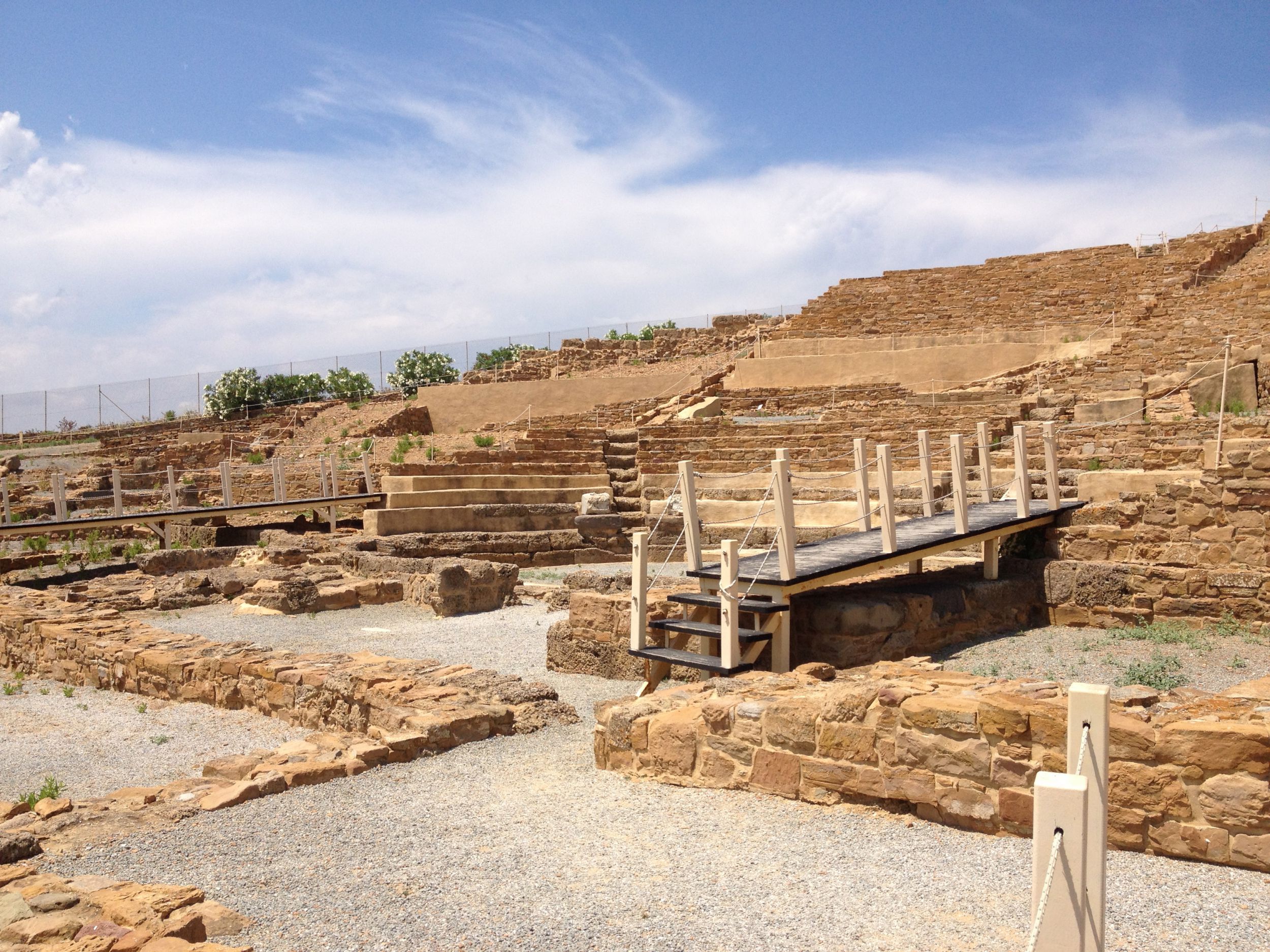 The discovery of a cemetery, dating from the middle of the 8th to the middle of the 5th century BC. and an important sanctuary, provide important information about the city of archaic times. The sanctuary, which was identified with the sanctuary of the Great Goddess and is built on the western sides of the peninsula, inside the city, was in use from the middle of the 8th to the middle of the 6th century BC, when it was violently destroyed.
The discovery of a cemetery, dating from the middle of the 8th to the middle of the 5th century BC. and an important sanctuary, provide important information about the city of archaic times. The sanctuary, which was identified with the sanctuary of the Great Goddess and is built on the western sides of the peninsula, inside the city, was in use from the middle of the 8th to the middle of the 6th century BC, when it was violently destroyed.
The remains of the theater, which dates back to the beginning of the Hellenistic period and was modified during the Roman era, are preserved.
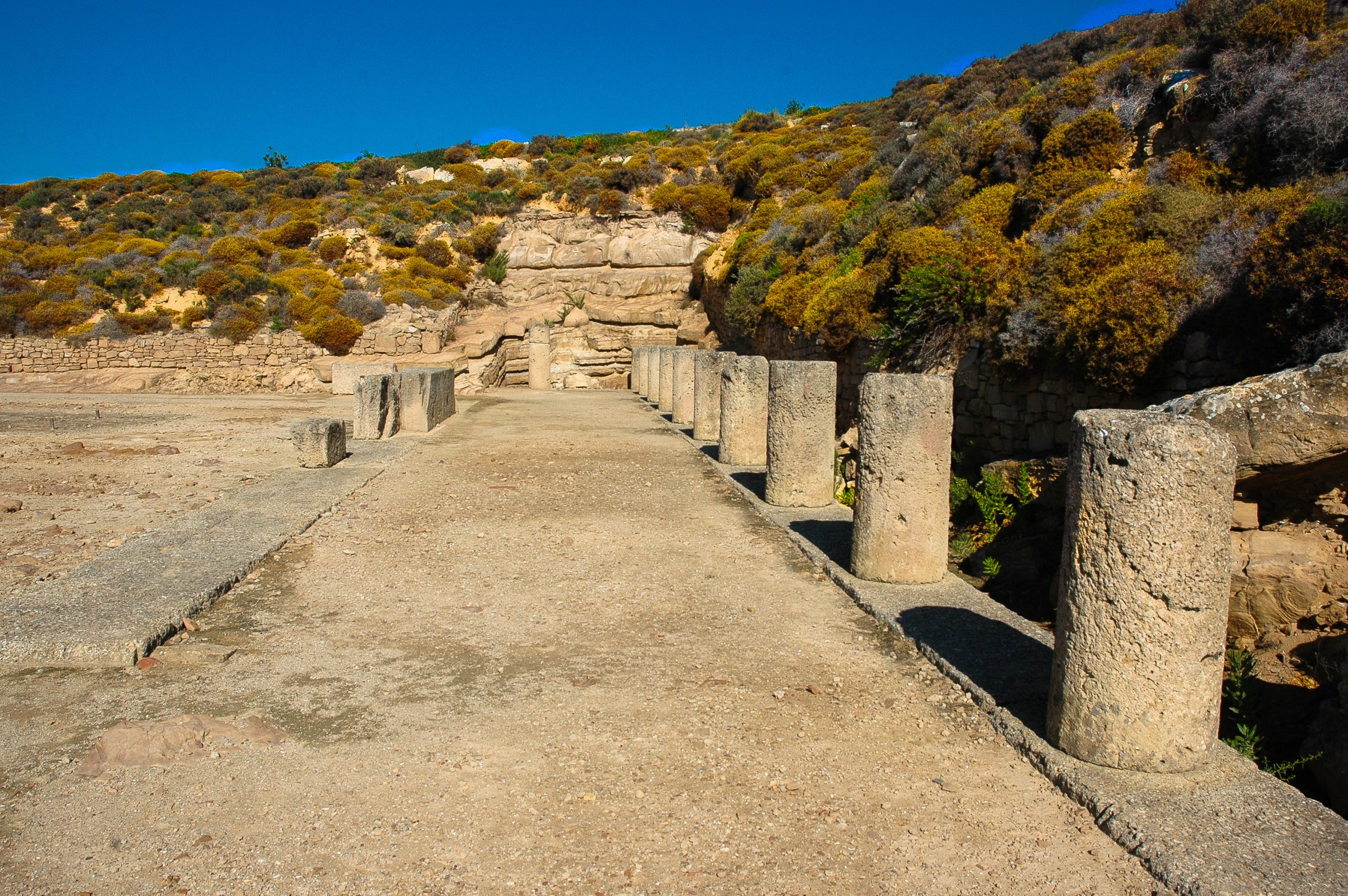 According to legend, Hephaestus passed on the knowledge of art to the Kaveri, children acquired by the nymph Kaveiro.
According to legend, Hephaestus passed on the knowledge of art to the Kaveri, children acquired by the nymph Kaveiro.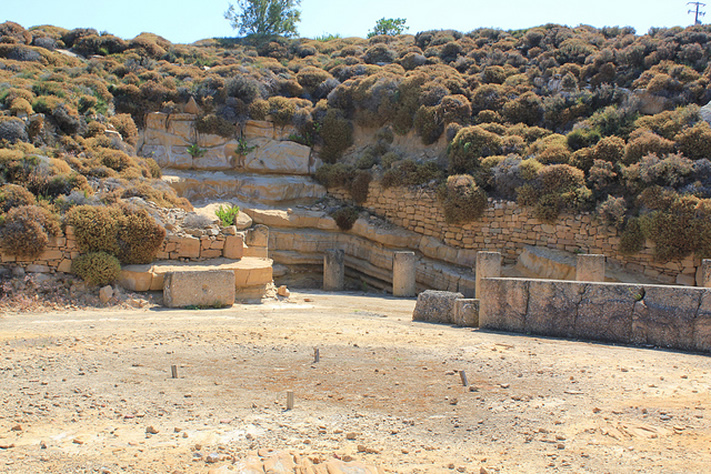 According to mythology, ‘Kaveiroi’ were the three sons and three daughters of Hephaestus and Kaveiros and were worshiped in Lemnos as deities, even in Samothrace.Their worship was intensely mysterious and included the ceremonies that became known as the ‘Kaverian Mysteries‘ and were related to the rebirth of nature and fertility. The worship and initiation ceremonies lasted nine days. During the ceremonies they extinguished all the fires on the island and sent a ship to Delos, to the island of the illuminator Apollo, to bring new light. Life on the island stopped until the arrival of the new light. Everyone was waiting for the ship to arrive with the new light to continue their life at a normal pace.
According to mythology, ‘Kaveiroi’ were the three sons and three daughters of Hephaestus and Kaveiros and were worshiped in Lemnos as deities, even in Samothrace.Their worship was intensely mysterious and included the ceremonies that became known as the ‘Kaverian Mysteries‘ and were related to the rebirth of nature and fertility. The worship and initiation ceremonies lasted nine days. During the ceremonies they extinguished all the fires on the island and sent a ship to Delos, to the island of the illuminator Apollo, to bring new light. Life on the island stopped until the arrival of the new light. Everyone was waiting for the ship to arrive with the new light to continue their life at a normal pace.
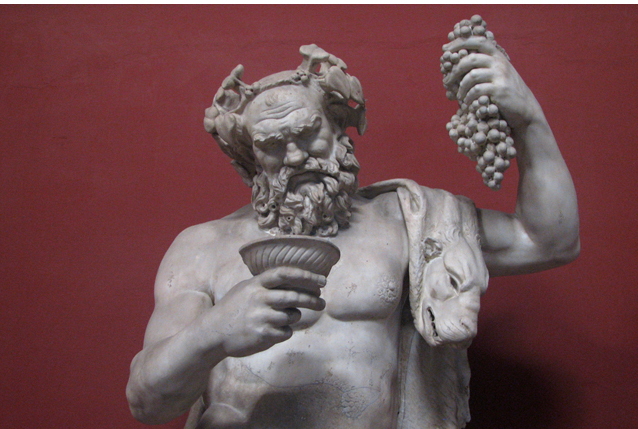 The introduction of viticulture was associated with Dionysus. According to legend, Minos of Crete sent the king of Phaistos Radamanthos to conquer the Aegean islands. He donated Lemnos to one of his generals, Thoantas, son of Dionysus and Ariadne, who taught the people of Lemnos the cultivation of the vine.
The introduction of viticulture was associated with Dionysus. According to legend, Minos of Crete sent the king of Phaistos Radamanthos to conquer the Aegean islands. He donated Lemnos to one of his generals, Thoantas, son of Dionysus and Ariadne, who taught the people of Lemnos the cultivation of the vine.
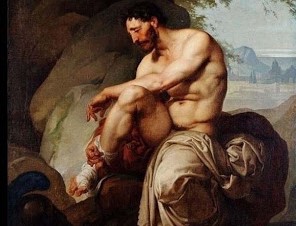
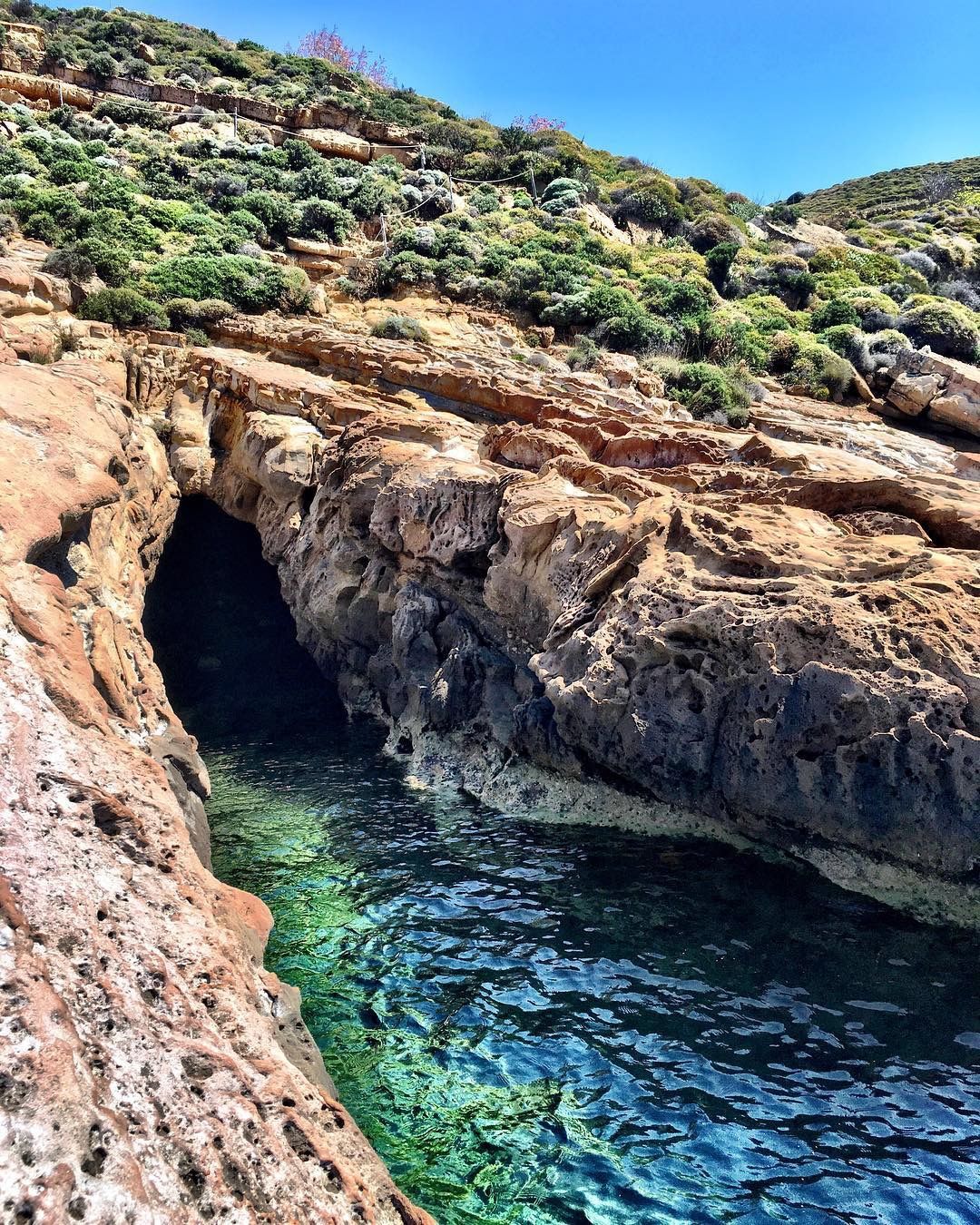 Also, in Lemnos was hosted Philoctetes, the mythical king of Melivoia when he was abandoned by his comrades, wounded by a snake bite on the island of Chrysi located NE of Lemnos (today submerged reefs Mythones), where he had gone to offer sacrifices on the altar of the goddess of the same name.He lived in a cave and was healed with the help of limnia land, a healing soil that exists in the area of Mosychlos.
Also, in Lemnos was hosted Philoctetes, the mythical king of Melivoia when he was abandoned by his comrades, wounded by a snake bite on the island of Chrysi located NE of Lemnos (today submerged reefs Mythones), where he had gone to offer sacrifices on the altar of the goddess of the same name.He lived in a cave and was healed with the help of limnia land, a healing soil that exists in the area of Mosychlos.
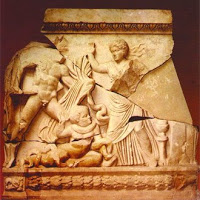 According to this legend, during the reign of Thoas, great earthquakes caused destruction on the island. The statue of Aphrodite, which was located next to the statue of “Limnia Voos”, was considered responsible for this. That is why they threw the statue into the sea. Aphrodite, wanting to avenge this disrespect, sent an unbearable stench to the female population of the island, so that the men would not approach them. When, afterwards, they brought a female population from Thrace, the women of Lemnos angrily decided to kill the male population of the island.When Ypsipyli found out about this, she fled to her father Thoanda so that they would not kill him. So Lemnos was left without men for some time until the time when Jason came with the Argonauts and they settled for a while. During this time, Ypsipyli married Jason and they had Evnios and Diipylos. The first became king of the island and helped the Achaeans significantly during the Trojan War.
According to this legend, during the reign of Thoas, great earthquakes caused destruction on the island. The statue of Aphrodite, which was located next to the statue of “Limnia Voos”, was considered responsible for this. That is why they threw the statue into the sea. Aphrodite, wanting to avenge this disrespect, sent an unbearable stench to the female population of the island, so that the men would not approach them. When, afterwards, they brought a female population from Thrace, the women of Lemnos angrily decided to kill the male population of the island.When Ypsipyli found out about this, she fled to her father Thoanda so that they would not kill him. So Lemnos was left without men for some time until the time when Jason came with the Argonauts and they settled for a while. During this time, Ypsipyli married Jason and they had Evnios and Diipylos. The first became king of the island and helped the Achaeans significantly during the Trojan War.
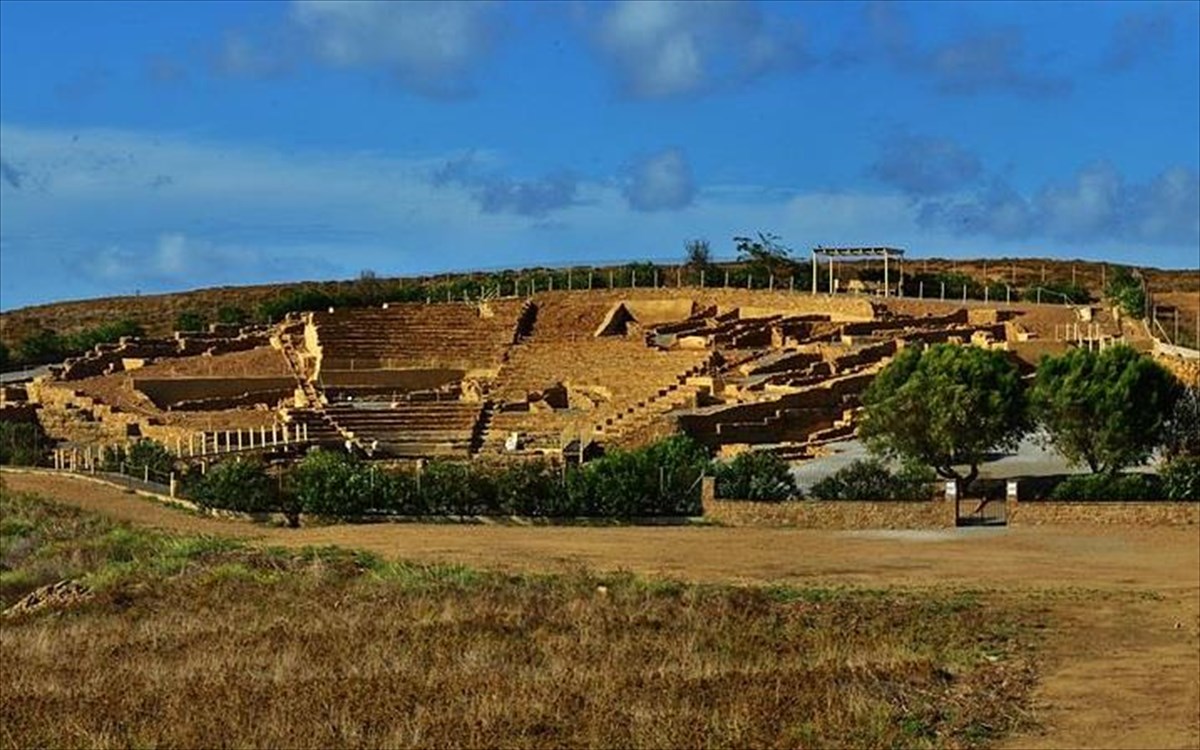 At least from the 8th century BC The Pelasgians settled in Lemnos, as well as in Imvros and Samothrace. They came persecuted from Attica and displaced the Minyans, who had ruled the island until then. However, they had a great cultural affinity with the Greeks, from whom they received many influences in art and religion. They had Hephaestia as their capital, but they lived all over the island. In the castle of Myrina is preserved part of the wall which they built. They were metallurgists and distinguished themselves in trade and the arts.
At least from the 8th century BC The Pelasgians settled in Lemnos, as well as in Imvros and Samothrace. They came persecuted from Attica and displaced the Minyans, who had ruled the island until then. However, they had a great cultural affinity with the Greeks, from whom they received many influences in art and religion. They had Hephaestia as their capital, but they lived all over the island. In the castle of Myrina is preserved part of the wall which they built. They were metallurgists and distinguished themselves in trade and the arts.
From the 8th century they settled in Hephaestia, where the archeological excavations found a cemetery and two large and rich sanctuaries dedicated to the Great Goddess Lemnos and the Kaviroi, sons of Hephaestus. Figures of exceptional style were found in them, such as sphinxes, sirens, etc.
Roman era
Lemnos was conquered by the Romans in 166 BC and experienced an era of calm and cultural rise with the culmination of the emergence of the family of the sophists Philostratus.
The first was the sophist Philostratus of Beirut, who acted in Athens during the 2nd century and left a number of books, of which only the “dialogue of water” survived. His son, Flavius Philostratus, also a sophist, taught in Athens and Rome, where he was the educator of the children of the emperor Septimus Severus (193-211). His most important works were: Lives of sophists, Ta in Tyanea Apollonius and Gymnast.
The nephew of the former was the sophist Philostratus of Nervianos, who taught in Athens, was in favor of the emperor Caracalla (211-217) and died in Lemnos, where he lived the last years of his life. His most important work is the Icons, while a number of many others are attributed either to him or to his ancestor Philostratus of Beirut. Such are the works: Iroikos, Lithognomikon, Peri tragodias, Rhetoriki aphormai, Zitomena para tois rhetorsi, Peri tou omenata, Protes, Theatis as well as 43 tragedies, 14 comedies, 4 Elefsiniakoi Logoi, many celebratory speeches.
Byzantium
In Byzantine times the island was used as a shipyard, where ships were built and maintained for the Byzantine fleet. Lemnos was part of the Aegean Theme and was threatened many times by piracy and especially the Saracens (9th century). After the Fourth Crusade (1204) it was occupied by the Venetians to be recaptured by the Palaeologans in 1278.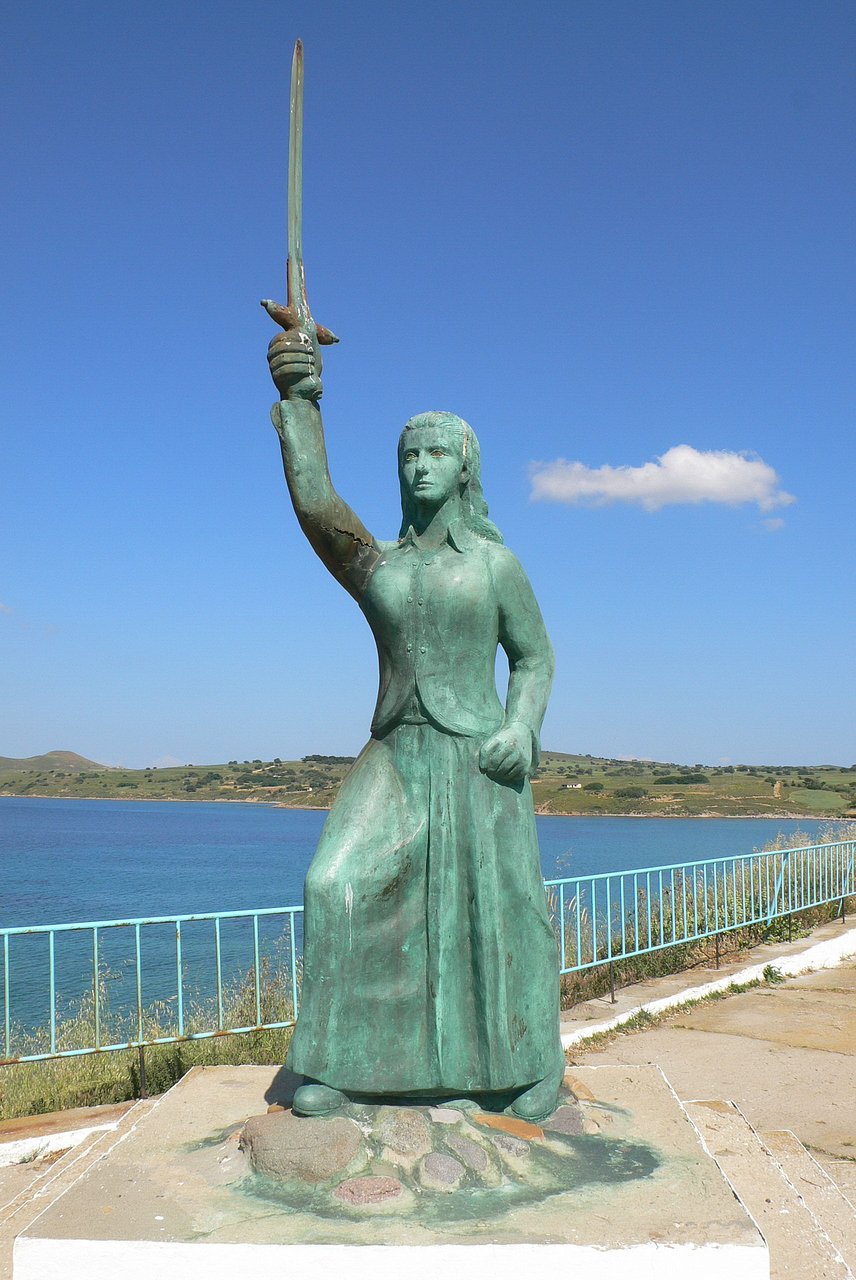
There is not much information about the island during the Byzantine period. In 325 AD. the bishop of Lemnos Stratigios took part in the first Ecumenical Synod. The next bishop of Lemnos appears in 680 AD. at the Sixth Ecumenical Council and is called Siluanos.During the reign of Constantine the Great, the island belonged to the Eastern Illyrian theme. From the 7th to the 11th century the Byzantines used the island to build ships and as a base for their fleet.In the middle Byzantine times the island belonged to the subject of Greece and later passed to the subject of the Aegean, while in the 11th century it passed to the control of Thessaloniki.
Byzantine rule was interrupted several times by the Saracens, the Venetians and the Genoese. The Turks never occupied the island. Whenever they tried, they met the heroic resistance of the islanders, culminating in the battle of Kotzino in 1475, where Maroula of Lemnos was distinguished.  Maroula was the daughter of Isidore Komnenos and Euphrosyne, who protected the area of Kotsina in the 15th century. On the feast of Constantine and Helen (May 21, 1478) Suleiman Pasha launched an attack on the island and so Greeks and Venetians defended the Turkish advance on the fortress. Maroula was 18 years old!
Maroula was the daughter of Isidore Komnenos and Euphrosyne, who protected the area of Kotsina in the 15th century. On the feast of Constantine and Helen (May 21, 1478) Suleiman Pasha launched an attack on the island and so Greeks and Venetians defended the Turkish advance on the fortress. Maroula was 18 years old!
At one point the defense of the Greeks and the Venetians began to recede and Maroula’s father was taken and all the officers dispersed. Then Maroula appeared, who raised the blood-stained sword of her father, who had just recovered in her arms, and rushed first into the battle, encouraging the others to attack. Thus the victory occurred and Suleiman left the battle humiliated.
In the port of Kotsina is today an imposing bronze statue of the legendary heroine in the courtyard of the Holy Temple of Zoodochos Pigi, on the hill where once stood the impregnable fortress of Kotsinos. This statue is a creation of Hippocrates Savouras and was funded by the Lemnos Teachers’ Association in the period of 1969. The island was finally ceded to the Turks by the Venetians in 1456 initially and in 1479 definitively.
Ottoman rule
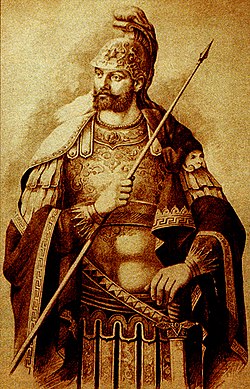 The first presence of the Turks on the island is mentioned in 1442 when they besieged it for 27 days. Among the besieged was Konstantinos Paleologos with his second wife Katerina Gatelouzos who died from hardship and a difficult pregnancy.In the following years the island declined until 1700 which passed in a period of calm and reorganization. Already the capital of the island is the Castle of today’s Myrina.In 1770 after Orlofika the island was destroyed again by the Turks and a period of persecution, destruction and uprooting began.In 1821 Lemnos due to its location near Constantinople did not revolt, although many Lemnos took part in the National Uprising and fought at sea and on land.In 1854, during the Crimean War, an attempt was made to liberate it, but it was violently blocked by the British fleet.
The first presence of the Turks on the island is mentioned in 1442 when they besieged it for 27 days. Among the besieged was Konstantinos Paleologos with his second wife Katerina Gatelouzos who died from hardship and a difficult pregnancy.In the following years the island declined until 1700 which passed in a period of calm and reorganization. Already the capital of the island is the Castle of today’s Myrina.In 1770 after Orlofika the island was destroyed again by the Turks and a period of persecution, destruction and uprooting began.In 1821 Lemnos due to its location near Constantinople did not revolt, although many Lemnos took part in the National Uprising and fought at sea and on land.In 1854, during the Crimean War, an attempt was made to liberate it, but it was violently blocked by the British fleet.
Release of the island
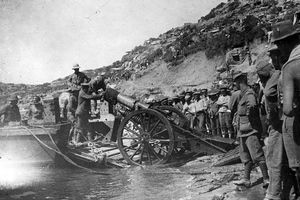
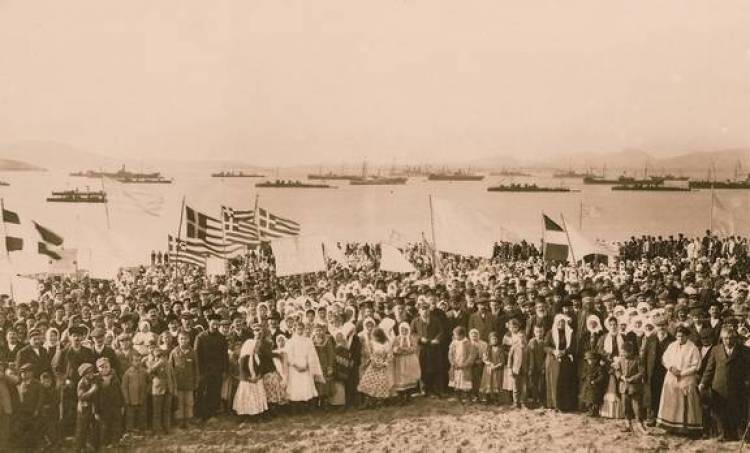 Lemnos was liberated on 8/10/1912 by the Greek fleet, only three days after the declaration of the All-Balkan War. Admiral Koundouriotis occupied the island and set up a naval base that controlled the straits of the Hellespont. During World War I, Lemnos became an English base and Moudros Bay became a naval base for the English fleet Kallipolis.
Lemnos was liberated on 8/10/1912 by the Greek fleet, only three days after the declaration of the All-Balkan War. Admiral Koundouriotis occupied the island and set up a naval base that controlled the straits of the Hellespont. During World War I, Lemnos became an English base and Moudros Bay became a naval base for the English fleet Kallipolis.
It was used by them as a base for the unfortunate landing operation in Gallipoli, Turkey, in which troops from Australia and New Zealand (ANZAC) took part. After the October Bolshevik Revolution and the defeat of the White Army, thousands of Russian refugees, mostly Cossacks, arrived in Lemnos. 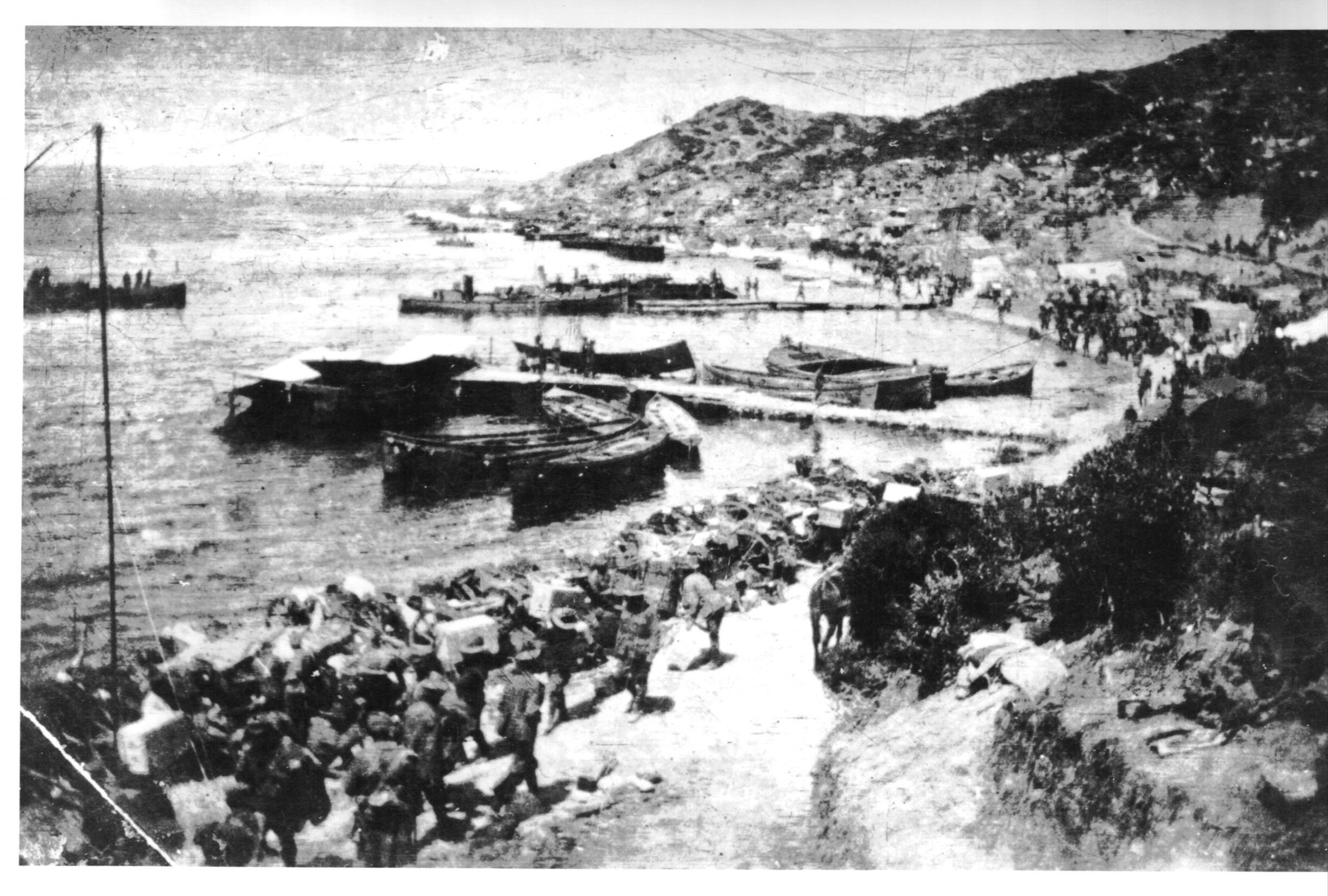 Many of them died on the island from disease and misery. Hundreds of victims of the campaign were buried on the island.
Many of them died on the island from disease and misery. Hundreds of victims of the campaign were buried on the island.
 On October 31, 1918, a truce was signed between the Allied forces and Turkey in Moudros, which effectively marked the end of the bloody war. After the Mikra Asia Catastrophe in 1922 and the exchange of populations, many Greek refugees from Mikra Asia settled on the island, enriching it culturally and economically. World War II brought German occupation of Lemnos until October 16, 1944.
On October 31, 1918, a truce was signed between the Allied forces and Turkey in Moudros, which effectively marked the end of the bloody war. After the Mikra Asia Catastrophe in 1922 and the exchange of populations, many Greek refugees from Mikra Asia settled on the island, enriching it culturally and economically. World War II brought German occupation of Lemnos until October 16, 1944.
After the civil war, Lemnos became a place of exile for the leftists defeated in the civil war and the miserable living conditions on the island caused mass migration both inland and abroad, mainly to Australia, Germany, USA, South Africa and Canada. Thus the population of the island began to decline.Typically in 1951 24,018 inhabitants were counted while in 1981 only 15,721. The associations of the Lemnian Diaspora contributed to the development of the island with their donations, mainly in the field of social welfare and education. A typical example is the Lemnos Hospital which was built with the contribution of the “Hephaestus” Association of New York in 1939 and in the 50’s and in the early 60’s it increases its equipment with small and large donations.











